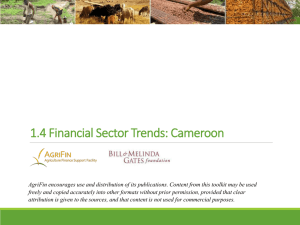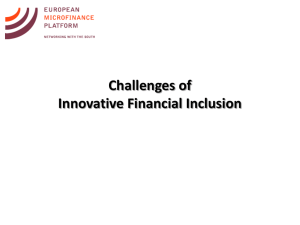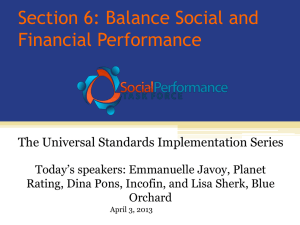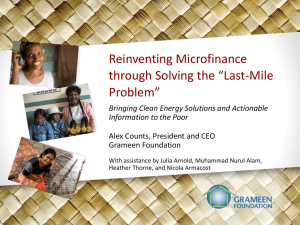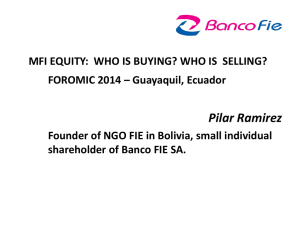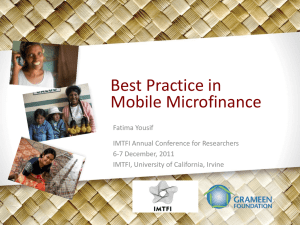COMMERCIALIZATION AND FOREIGN INVESTMENT
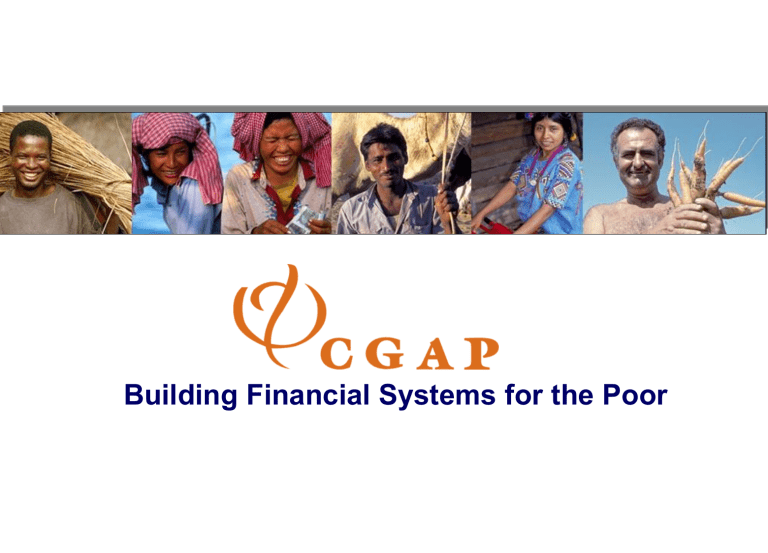
Building Financial Systems for the Poor
GLOBAL TRENDS IN
MICROFINANCE:
COMMERCIALIZATION AND
FOREIGN INVESTMENT
Baku, Azerbaijan
May 27, 2006
Olga Tomilova,
CGAP-MFC Central Asia Microfinance Center
2
CGAP – Consultative Group to Assist the Poor
Microfinance Consortium of 31 public and private development agencies working together to expand access to financial services for the poor in developing countries.
Resource center and standard setting body for the entire microfinance industry.
CGAP serves four groups of clients:
development agencies,
financial institutions including microfinance institutions (MFIs),
government policymakers and regulators, and
other service providers, such as auditors and rating agencies.
Specialized services: advisory services, training, research and development, consensus building on standards, and information dissemination.
3
MF and Access to Finance
MF has made a relatively rapid impact, has achieved significant outreach, and can become sustainable within relatively short period of time
Access to finance enhances growth and helps reduce poverty
MF is now a real industry
BUT:
Big differences between regions (LAC, SA, ECA, MENA), and between countries
2 billion people still lack access to formal financial services
4
Global providers of microfinance services
750 million accounts in “social” financial institutions, many likely to be poor
Commercial
Banks
2%
NGOs/NBFI
5%
COOPs
6%
Postal
Banks
51%
Rural Banks
17%
Ag & State
Banks
19%
Source: CGAP, 2004
5
Microfinance is melting into financial sector
Commercial banks move into MF
50 countries discuss and implement microfinance policies
MFIs are audited and comply with the IFRS
12 rating agencies rate MFIs
(Standard & Poor’s,
Moody’s)
Financial System
Unregulated
MFIs report to national credit bureaus
(Turkey, Peru) MFI bank issues VISA credit cards (Paraguay)
MFI clients access international ATM networks
(Dominican Republic)
6
Each country’s model is different
• Stage of financial sector development
• Existence of infrastructure
• Population density
• Levels of poverty
• Competition
Self-Help
Groups
Credit Unions
Financial
NGOs
State Banks
Commercial
Banks
Co-ops
Postal Banks
Rural Banks
7
Access points are multiplying
Leveraging existing + new infrastructure to offer multiple access points
State
Banks
Commercial
Banks
MFIs
Lottery Agent
Loan Service
Agent
Self-Help Groups
PC Kiosk
Point-of-Sale
Networks
Traders and
Processors
ATMs
CLIENTS
8
MFI- Bank partnerships taking off
Using a range of risk in their engagements
Higher level of engagement
Bank creates loan service company
Bank invests equity in
MFI
Bank buys MFI portfolio and / or contracts MFI operations
Wholesale lending
Sharing / Renting facilities
Bank provides front or back office functions
Sogebank, Haiti
Created loan service company Sogesol in 2000
Jammal Trust Bank and Credit Libanais, Lebanon
Have equity stake in Ameen, a CHF microfinance program
ICICI Bank, India
Contracts microfinance operations with self-help groups and MFIs
Raffeissen Bank, Bosnia
Lends to multiple MFIs in Bosnia
Garanti Bankasi, Turkey
Provides front office functions through branch network to Maya Enterprise for Microfinance
Microfinance Bank, Georgia
Rents space in its offices to Constanta, a local NGO
Lower level of engagement
9
Pioneer, breakout, consolidation and maturity?
Most efficient, effective, client service oriented institutions will prevail and have access to funding sources
Grameen
Prodem
~10,000
MFIs
M&A
Failures
Formal FIs
Top-tier
NGO/MFIs
10
Downscaling
Downscaling: A bank or other formal financial institution expands its services to work with clients traditionally served, if at all, only by MFIs.
Such an expansion can mean serving microfinance clients in one or many financial areas
History: First “multi-global” operations financed by IDB in early 1990s.
EBRD adapted and applied the concept in Russia and other NIS countries. Approach is again becoming popular (IFC/Accion, WWB)
Significance LAC: 27 out of top 32 MFIs in LAC are commercial institutions, RoA for this group: 4.8%. Examples: Banco del Trabajo and
Banco del Cr édito (Peru), Banco Caja Social (Colombia), Financiera
Vision (Paraguay)
Significance ECA: Russia, Kazakhstan and Ukraine – 137,000 borrowers,
$ 712 m LPF; commercial banks and greenfield banks have highest growth rates in the region
11
Downscaling in ECA – Portfolio $
Dec-02
Kazakhstan 73.39
Ukraine 29.64
Russia 173.49
Kyrgyzstan 0.57
Dec-03
148.99
55.51
228.98
2.59
Dec-04
251.02
Performance
(Dec02-
Dec04)
Share in
Total (Dec03)
Share in
Total (Dec04)
+242% 33% 35%
104.59
+253% 12% 15%
307.79
11.3
+77%
+1882%
50%
1%
43%
2%
TOTAL 277.09
436.07
674.7
+145%
12
High Relevance of Banks in ECA
% Borrowers by Type of MFI 2002 g e t a r c e n
P e
100%
90%
80%
70%
60%
50%
40%
30%
20%
10%
0%
5
0.7
94
EAP
Source: MIX Database
45
24
5
8
20
0.4
20
96
55
EECA
63
LAC
0.9
3
MENA
60
Africa
26
S Asia
74
Non-Profit
OTHER
CU/COOP
NBFI/Bank
13
Downscaling – Summary
Downscaling model is one (but increasingly important) element in sensible approach to access to finance
Secured lending and credit bureaus will make positive impact
Commercial banks unlikely to reach the poorest segments of potential retail customers
Commercial banks unlikely to solve rural finance dilemma
Other (complementary) approaches:
Greenfield banks
CUs
Upgrading NGOs
Linking (cooperation between MFIs and Banks)
14
Downscaling – Summary
Access to Finance and especially downscaling can and should be integral part of successful regional development strategy
Government support is needed to ensure conducive environment for investment and growth of financial services industry
Don’t subsidize interest rates, don’t cap interest rates
Subsidize TA
Don’t build monopolies, enhance competition
15
Predictions
Multiplying points of service allows exponential growth
Technology and infrastructure are key drivers to scale
Commercial and state banks will become core providers
Major consolidation of MFIs will occur through buy outs by banks, mergers, partnerships, and wind-downs
Domestic sources of funds will become even more important
(savings, commercial debt)
Donors will focus on frontier markets (very poor and rural)
16
FOREIGN INVESTMENT IN
MICROFINANCE
17
CGAP Foreign Investors Survey
Survey of 54 foreign microfinance investors conducted by CGAP, MIX and ADA (June – September 2004)
Purpose – ascertain legal structures, investment focus and history, availability of uncommitted funds, and financial performance
Data on “direct” investments in 505 MFIs and “indirect” investments in 25 MF funds
Amount of foreign investments (disbursed and committed):
$1.2 billion – direct
$611 million - indirect
18
Where is the Foreign Investment Going?
Foreign investment in MFIs takes the form of:
Equity
Debt
Guarantees
Only regulated MFIs are legally structured to receive all three forms of investments – non-regulated cannot receive equity investments
Among 505 MFIs surveyed, 166, or 33% are regulated institutions
Heavy concentration of foreign investment in certain regions – 87% in Latin America and Eastern
Europe/Central Asia
19
Where is the Foreign Investment Going?
By instrument:
Debt – 69%
Equity – 24%
Guarantees – 8%
By legal status – 82% to regulated MFIs
By size of investment – 89% over $1 million
By suppliers – nearly half of all investment is provided by four IFIs: IFC, EBRD, KfW and USAID’s Development
Credit Authority
Two thirds of investment is provided by 6 of 54 funds
20
Are Foreign Investments Competing to Find
MFIs to Invest in?
Numerous anecdotal suggestions that investors are not finding it easy to place funds in MFIs that meet their standards
Tendency for multiple investors to invest in a single
MFI – for example, 20 out 54 funded Banco Solidario
(Ecuador), 15 funded Confianza (Peru), and 11 funded
Fundacion Nieberowski (Nicaragua)
The reason is not small investment amounts, but rather excess of supply over demand from suitable MFIs, i.e. those that meet the investors’ quality and risk profile
Instances of a single investor funding the same institution through several indirect channels
21
Why MFIs Seek Foreign Investment
Motivating factor
Lower interest rate
Easier collateral requirements
Investor’s willingness to negotiate
Length of loan
Speed of disbursement
Ability to attract other lenders and investors
% of respondents rating factor as
“extremely important” and “important”
36 Regulated 112 Unregulated
86% 78%
69%
69%
72%
66%
61%
56%
56%
66%
65%
60%
22
Uncertain Demand for Equity – Regulated MFIs
Regulated MFIs will continue to seek more debt than equity from foreign sources:
High levels of equity capital greater interest in increasing liabilities
Most MFIs have lower levels of legally allowed leverage
Council of MF Equity Funds revealed that only 115 out of several thousands of MFIs would be candidates for foreign equity investments, given their legal status, profitability and size
Regulated MFIs are increasingly seeking domestic deposits to fund their liabilities
23
Uncertain Demand for Equity – Unregulated MFIs
Unregulated MFIs – more numerous, but are not structured to take equity investments more likely to seek foreign debt than regulated MFIs:
Less access to domestic banks
Generally prohibited from taking deposits
Foreign lenders will be attractive if they would lend beyond 1-to-1 debt-to-equity ratio and lower collateral requirements
Unregulated MFIs may have a relatively greater interest in foreign debt investment compared to regulated MFIs
24
Foreign Debt and Currency Risk
Most of MFI assets tend to be denominated in local currency creates foreign exchange risk if they borrow foreign currency loans
Local currency in many developing countries is more likely to devalue than to appreciate
92% of debt issued to MFIs is in hard currency
Many MFIs are not alert to this issue – out of 105 MFIs surveyed, only 25 fully hedged their currency risk
In most developing countries, adequate hedging mechanisms are not available or too expensive
25
Conclusions: Practical Lessons
Foreign investors would add more value to the market if they were able to tolerate more risk, and thus work with less-well-established MFIs
Regulated MFIs should be helped to access more local funding use of guarantee mechanisms; improving credibility of MFIs with local funding sources
MFIs and investors need to be alert to the foreign exchange risk entailed by hard-currency loans
26
UNCDF

